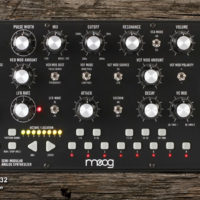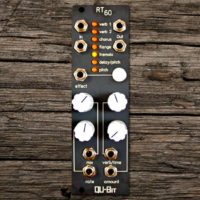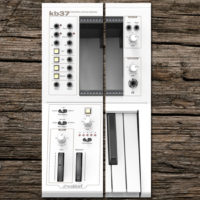The Moog 2600?
THE MOOG 2600?
One of the many wonderful things about the Eurorack modular standard is that it lets you combine and assemble modules from different manufacturers into a custom dream system, that only you may have.
I was intrigued by the KB-37 Eurorack keyboard from Waldorf, consisting of a quite potent controller keyboard, with room and power supply for a selection of Eurorack modules.
MODULE SELECTION
After settling on the quite large Moog Mother-32 module as being a part of the system, I still had some space left for modules to complement the Moog. Since the dawn of synths there has been a strive for dominance between the Moog and the Arp synths and modulars, so it was a no-brainer to add an ARP-inspired module to the case – the “Tonestar 2600” from Studio Electronics. This would give a nice combo of Moog and Arp, with 2 independent splittable and stackable synth voices under one roof.
With still room for a few more modules, I added the QuBit RT-60 FX-unit to supply reverbs, delays, chorus etc. But since this had only one input I needed a small mixer also. The Erica Synths Pico mixer module (3in>1Out) fit the bill and the available space, and makes for rudimentary but functional mixing of the onboard sound sources. Finally a Erica Synths Random Source module was added as a modulation source, along with a Doepfer passive multiple.
SYNTH COMPONENTS
This makes for a very potent and versatile monophonic synth on a very limited space. The modules are of course fully compatible with the remaining modular system. The ARP-2600 filter sounds distinctively different from the Moog filter, and the 2 modules have features that complement each other well.
PERFORMANCE OPTIONS
The KB-37 has a comprehensive set of controls, with CV and Gate outputs, as well as separate outputs for Mod.Wheel and Pitch Bend. After Touch is well implemented and has its own output, too. The onboard Arpeggiator is fairly basic, but does a good job. All programming is done by means of a Shift Key held in conjunction with pressing keys on the keyboard. This allows you to set MIDI channel, various sync modes and various arpeggiator settings.
SEQUENCE & ARPEGGIO
The Mother module contains a basic, but very useful sequencer that adds considerably to the possibilities.
And the onboard arpeggiator in the Waldorf does a very good job as such. When the arpeggiator is patched to the ToneStar module and the Mother is controlled by the sequencer you can create exciting and complex rhytmic stuff. Or one element could play the rhythm part, while the other plays the lead. Since it is effectively 2 different synths with split and layer capabilities you have a very deep and versatile sound engine with a potent controller on a very small footprint.






